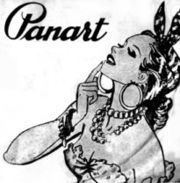Genre Cuban music Date founded 1944 Defunct 29 May 1961 | Founder Ramón S. Sabat | |
 | ||
Artists | ||
Panart was the first and most successful independent record label in Cuba, founded in 1944 by engineer Ramón Sabat. In 1961, its studios were seized by Fidel Castro's communist regime and the label was nationalized, becoming "Panart Nacionalizada", which shortly after was absorbed by EGREM.
Contents
Together with RCA Victor's, Panart studios were the main recording studios in Cuba during the 1950s. Since the 1960s, they are known as the Areito studios, owned by EGREM. In addition, Panart acted as a distributor for Odeon, Musart, Sonora and Capitol Records.
Origins and expansion
After studying music, joining the army and obtaining a degree in engineering, Ramón Sabat began working in several music labels in New York City. In 1943, the label he was working in, Musicraft, folded, and he decided to bring the necessary assets to Cuba to fulfill his desire of establishing his own Cuban-based record company. Thus in 1944 Sabat became the founder and president of the Cuban Plastics & Record Corporation. According to Irais Huerta Rubio, the majority stockholder of the company was a Cuban electric company controlled by an American holding company. In 1945, the company sold the whole of its shares to Sabat, becoming the sole owner of the company and launching it under the name Panart (sometimes stylized Pan-Art, short for Panamerican Art). His wife, Julia Sabat, became the vice-president, and millionaire Enrique Gorrín became its treasurer. The company's headquarters and recording studios were at San Miguel 410, between Campanario and Lealtad, in Havana, while the pressing plant was located outside of the city. The first record released by Panart (cat. no. 1010) was a 10" single by Orquesta Hermanos Castro with the songs "Cucha el eco del tambó" and "Toda una vida".
In 1952, Panart obtained exclusive rights for the pressing of music licensed by Decca. A few years later this contract was broken as Decca reached an agreement with EMI/Capitol. The expansion of the record label was nonetheless unprecedented for a Caribbean label. After establishing a subsidiary (Panart Recording Corporation) in New York in 1952, the same year it pressed its first LPs, Panart was pressing half a million records a year, 20% of which was exported outside of Cuba (over 50% by 1959). Its dominance over the jukebox business in Cuba and the strategic (geographical) advantage over its main competitor, RCA Victor, explain part of Panart's success. Moreover, Panart was able to secure contracts with some of the most popular and innovative musicians and groups in the country, from Conjunto Casino to Julio Gutiérrez and Cachao.
Nationalization and aftermath
After the Cuban Revolution, Cuban culture, including the record industry, was to be nationalized. In 1960, RCA Victor created a Cuban imprint, Discuba, which lasted until 1962. Panart's fate was somewhat different, on May 29, 1961, its studios and factory were seized by the government. By that time, Ramón and Julia Sabat were already in the US. For a short period of time, until 1962, Panart's records were sold as "Panart Nacionalizada" to reflect this. Between 1962 and 1964, the Imprenta Nacional the Cuba acted as the only legal Cuban label. In 1964, the EGREM "trumpet" logo began to be used in stickers put over the Panart logo of previously released albums, and by the time Areito was founded as EGREM's main imprint in Panart's former facilities, Panart had disappeared from Cuban record stores.
Thanks to Julia Sabat, who sent the master copies from Havana to New York, around 80% of Panart's catalogue was "saved" before the government took over the company. Julia and her daughter then left Havana shortly after the Revolution, while Ramón remained in Cuba in charge of the company. Finally, in 1961, they managed to get Ramón out of Cuba. He and his wife established themselves in Miami. Julia started working in a record factory in Hialeah with Ramón's brother, Galo.
Competition
Besides having to compete with major American record labels, primarily RCA Victor, and to a lesser extent, Capitol, Panart had to compete with numerous independent Cuban records labels that were established during the 1950s following the success of Sabat's company. These Cuban labels include Puchito, Kubaney, Suaritos, Gema and Maype amongst others.
